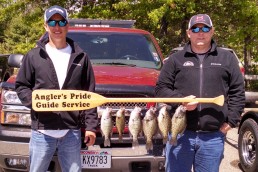Walleyes Love Weeds in Gin-clear Waters
SHARE THIS POST
After having chased walleyes in both the United States and a couple of Canadian provinces, I am convinced that they can be caught in just about any kind of water. But catching them in ultra-clear water is one of the greatest challenges any angler will face. However, it can be done if one is prepared to adapt to the conditions.
Walleyes, much like any other predatory fish, will not be active during a lot of the daylight hours in the shallows of clear-water lakes. Unlike “dirty” lakes, shallow may be a relative term in a clear-water environment. Two to three feet may be shallow in a stained lake, but in a clear lake, 10 feet may just be the beginning of the shallows.
The key, according to professional anglers with whom I have spoken as well as those with whom I have fished, is to search for weed lines. Any type of weed offers safety and sanctuary for a walleye in clear water. While fishing the weeds, make very long casts so as not to spook the fish and always fish above them.
Walleyes almost always “feed up” and will rise to attack a lure or a live bait offering. Weeds almost always are good for anglers because they provide feeding areas for fish as well as a place for fish to flee when danger threatens. They also offer shade from the bright sun and tend to reduce the temperature level of the water.
It stands to reason that walleyes in a clear water environment are going to be super-spooky, so it goes without saying that some of the prime times to fish would be early in the morning or late in the evening when light penetration angles are at their lowest points. During these low-light periods, the fish will prowl either the outside or inside weed edges searching for prey. Groups of walleyes tend to concentrate in what is called inside turns; those places where the weed lines form an inside curve.
Not there? Probe long, weedy points that extend for hundreds of yards out into the lake. Walleyes tend to hang out in both areas. Remember to stay back as far as possible from the weed lines. Make long casts and if possible, drop anchor and fish from your still boat.
Are you enjoying this post?
You can be among the first to get the latest info on where to go, what to use and how to use it!
Definitely a change of tactics is necessary in such a situation. Where you normally would use a number 5 Shad Rap, switch to a Number 13 floating Rapala and use it to probe both edges of the weeds. In many instances, the fish will hold on the inside edge of the weed line. The lighter floating lures will make less noise when dropped on the water and they offer a slimmer profile that closely imitates baitfish on which the walleyes feed.
Bear in mind that walleyes are notorious followers and sometimes will trail a bait for a good distance before biting. Felt a nip on your lure, but no fish? This is a sure sign of an inactive, but curious fish that is just half-heartedly striking. Try adding half a juicy night crawler to the front hook of your lure to offer more profile and to “scent up” the water. Still no luck? Try switching to red Daiichi Bleeding Bait trebles on your front split ring and adding a three-inch piece of Gulp crawler or leech. The red simulates the “gill flash” of a feeding baitfish and the Gulp offers scent and taste appeal. Both can and will trigger strikes from reluctant biters.
Not much luck in the weeds? Find a “mud line” of some type, either where a river flows into a lake or off the windward side of a long point. Walleye are dirty-water biters for several reasons. Their “wall eyes” offer substantially better sighting capabilities in dirty water than those of the prey that they pursue. Plus, their prey in a clear lake will instinctively seek out the dirtiest water to feed because it offers a hiding place, or so they think.
One last trick to try is to pull the slip bobber rig out of your tackle box and tip it with a minnow, leech, or lively nightcrawler. This will present more difficulties in the weeds but a slip bobber can be fished here without becoming snagged if you are careful. It is much easier to fish in these conditions than in stained or dirty water. When the bobber dips do not become overanxious about setting the hook. Take up the slack in your line or you will not get a good hook set. Keep your rod tip high and when you feel the fish, set the hook.
Weed beds need to be found on your electronics because they surely will not show up on a contour map. In clear-water lakes they can be found anywhere from about 12 to 25 feet. Once they are found, they can offer some pretty fine fishing in clear water lakes.
MWO
SHARE THIS POST
Did you enjoy this post?
You can be among the first to get the latest info on where to go, what to use and how to use it!
John Bennett
John Bennett is a retired history teacher, historical re-enactor, father and grandfather. As a four-season outdoorsman, his passion is waterfowl hunting and fishing for smallmouth bass. He lives in Ohio and spends quite a bit of time in his primitive log cabin, which he built.



